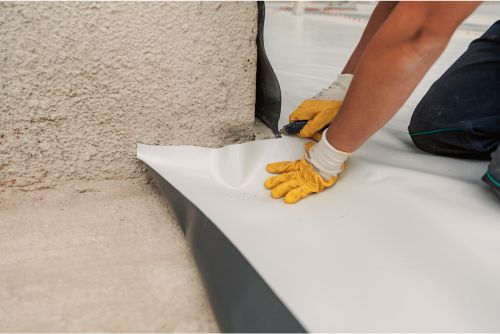
The roof is an essential part of any building, providing protection, insulation, and durability. When it comes to roofing materials, there are various options available, each with its own advantages and considerations. One such material is TPO roofing, which has gained popularity in recent years. But can you put TPO over shingles? In this blog, we will explore TPO roofing, its benefits, and the process of installing it over shingles. By the end, you will have a better understanding of whether TPO roofing is the right choice for your roofing project.
TPO roofing, also known as thermoplastic polyolefin roofing, is a single-ply membrane that is commonly used for flat roofs. It is made of a blend of polypropylene and ethylene-propylene rubber, which results in a durable, lightweight, and flexible roofing material. TPO roofing is designed to withstand extreme temperatures, making it suitable for various weather conditions. The TPO membrane is highly resistant to tears, punctures, and impacts, providing excellent protection against leaks and moisture. Additionally, TPO roofing offers excellent UV resistance, reducing heat absorption and energy costs.
TPO roofing, short for thermoplastic polyolefin roofing, is a popular roofing material for flat roofs. It is a single-ply membrane made from a blend of polypropylene and ethylene-propylene rubber, resulting in a durable, lightweight, and flexible material. TPO roofing is designed to withstand extreme temperatures, making it suitable for various weather conditions. The TPO membrane is highly resistant to tears, punctures, and impacts, providing excellent protection against leaks and moisture. Its excellent UV resistance also reduces heat absorption, resulting in energy cost savings.
TPO roofing offers several benefits that make it an attractive choice for many building owners. Firstly, TPO roofing is highly durable, able to withstand extreme weather conditions, and resist leaks and moisture. This durability ensures a long lifespan for the roof, reducing the need for frequent commercial roof repairs NJ or replacements. Additionally, TPO roofing is energy-efficient, reflecting sunlight and reducing the roof’s surface temperature. This, in turn, lowers cooling costs, making it a cost-effective choice for both residential and commercial buildings.
Now that we have a better understanding of TPO roofing, let’s compare it to shingle roofs. Shingle roofs, particularly asphalt shingles, are a common roofing option for residential properties. They are cost-effective and offer a wide range of design options, allowing for aesthetic versatility. However, shingle roofs have their drawbacks. They have a shorter lifespan compared to TPO roofs, requiring more frequent maintenance and replacement. Shingle roofs are also susceptible to moisture damage, which can lead to commercial leak repair NJ and other structural issues.
While shingle roofs have their advantages, there are several reasons why you might choose TPO roofing over shingles. Firstly, if you’re in need of a new roof, TPO roofing provides a durable and long-lasting solution. It offers better protection against leaks and moisture, ensuring the integrity of your roof system. Additionally, TPO roofing is more energy-efficient, reflecting sunlight and reducing the roof’s surface temperature. This can result in cost savings on cooling expenses. If you’re considering a roof replacement, TPO roofing can be an excellent choice for its durability and energy efficiency.

Now, let’s delve into the installation process of TPO roofing over shingles. Before installation, proper preparation is essential. The existing shingle roof needs to be thoroughly inspected for any damage or structural issues. Repairing and cleaning the existing roof will ensure a smooth surface for the TPO installation. Insulation is then installed over the shingles to improve the thermal performance of the TPO roofing system. Special attention is given to addressing existing moisture or leakage issues. A comprehensive assessment of the existing roof conditions is conducted to determine the suitability of TPO installation and if can you put TPO over shingles.
Before installing TPO roofing over shingles, proper preparation is crucial. The existing shingle roof should be thoroughly inspected for any damage or structural issues. Repairing and cleaning the existing roof will ensure a smooth surface for the TPO installation. Additionally, insulation is installed over the shingles to enhance the thermal performance of the TPO roofing system. Preparing the existing roof for TPO installation involves addressing any existing moisture or leakage issues. A comprehensive assessment of the existing roof conditions is conducted to determine the suitability of TPO installation.

As with any roofing project, cost is an important factor to consider when installing TPO roofing over shingles. The average cost of TPO roofing installation varies based on square footage and labor costs. Generally, TPO roofing is a cost-effective option compared to other roofing types. The total cost of TPO roofing installation includes labor, materials, and insulation. It’s worth noting that weather conditions can impact the installation cost, particularly during winter months. Considering the long-term durability and energy efficiency of TPO roofing, it offers a cost-efficient solution for those looking to invest in a new roof system.
The average cost of TPO roofing installation varies depending on the square footage of the roof. On average, TPO roofing costs around $5-$8 per square foot, including labor and materials. For a 1,500 square foot roof, the total cost of TPO roofing installation can range from $7,500 to $12,000. It’s important to note that these costs may vary based on location, roofing services, and other cost factors. When considering the cost of TPO roofing, it’s essential to consider the long-term durability, energy efficiency, and low maintenance requirements of TPO.
Several factors can influence the cost of installing TPO roofing over shingles. Firstly, labor costs can vary depending on the complexity of the roofing project and the region’s labor rates. The choice of roofing services can also impact the overall cost, as some commercial roofing company NJ may charge more for TPO installation. Additionally, the extra weight of TPO over existing shingles may incur additional costs, as extra support may be required. Other cost factors, such as the need for TPO flashing and seams, should also be taken into consideration when budgeting for TPO roofing installation.

Now, let’s compare TPO roofing with other types of roofing materials. Two common comparisons are TPO roofing vs metal roofing and TPO roofing vs asphalt shingles. Both metal roofing and asphalt shingles have their advantages, but TPO roofing offers unique benefits that may make it a more suitable choice for many projects. TPO roofing provides superior moisture resistance, durability, and insulation compared to asphalt shingles. It also offers a cost-effective alternative to metal roofing, with excellent weather resistance and durability.
When comparing TPO roofing with metal roofing, there are several considerations to keep in mind. TPO roofing is generally more cost-effective than metal roofing, making it a popular choice for commercial roofing projects. TPO roofing also has a lower carbon footprint than metal roofing, as it does not require as much energy-intensive manufacturing processes. Additionally, TPO roofing provides better insulation and durability compared to metal roofing, making it a reliable choice for any roofing project.
TPO roofing and asphalt shingles are popular roofing options, each with its own advantages. TPO roofing offers better moisture resistance, insulation, and durability compared to asphalt shingles. It provides a sleek, flat roof appearance, allowing for aesthetic customization. Additionally, TPO roofing requires less maintenance and offers a longer lifespan compared to asphalt shingles. While asphalt shingles may be more cost-effective initially, TPO roofing is a cost-efficient choice in the long run, considering its durability and low maintenance requirements.
Real-life examples can provide valuable insight into the benefits of installing TPO roofing over shingles. In one case study, TPO roofing was successfully installed over an existing roof system, improving insulation, durability, and weather resistance. The project showcased the advantages of TPO roofing, particularly in extreme winter months. When considering whether TPO roofing is the right choice for your roofing project, it’s important to evaluate your roof’s condition, weather conditions, and specific requirements. Consulting with roofing professionals can help determine the best options and provide real-life examples of successful TPO roofing installations.
In a recent case study, a residential roofing project involved installing TPO roofing over an existing shingle roof system. The installation of TPO roofing provided a long-term, durable solution that improved insulation, weather resistance, and energy efficiency. The project showcased the benefits of TPO roofing, particularly in extreme weather conditions. By choosing TPO roofing over shingles, the homeowner gained a low slope roof system that offered superior protection against moisture, leaks, and structural issues. This real-life example demonstrates the effectiveness of TPO roofing and its potential as a reliable choice for residential roofing projects.
When considering TPO roofing for your roofing project, several factors should be taken into account. TPO roofing is an excellent choice for commercial roofing, particularly on low slope roofs. Its durability, moisture resistance, and energy efficiency make it a reliable option for long-term cost savings. However, it’s important to assess the weather conditions, existing roof system, and project requirements before making a decision. Consulting with roofing professionals can help determine whether TPO roofing is the best option for your specific needs.
In conclusion, TPO roofing offers numerous benefits over traditional shingle roofs. It provides better durability, energy efficiency, and resistance to weather elements. While shingles have their advantages, such as lower cost and ease of installation, TPO roofing is a superior option for long-term performance and value. If you’re considering installing TPO over shingles, it’s essential to understand the process involved and consider the cost implications. Consulting with a professional commercial roofing contractor NJ will help assess your specific needs and determine if can you put TPO over shingles and if TPO roofing is the right choice for you. Invest in the longevity and quality of your roof by choosing TPO roofing for your home or commercial property.